Ecosystem consequences of a changing dust cycle
The emission and deposition of atmospheric dust, aerosols, and nutrients can have far-reaching ecological consequences. For instance, the erosion of soil by strong katabatic winds off the Greenland Ice Sheet disturbs vegetation, resulting in distinct bare patches dominated by biological soil crust. In the Colorado Rocky Mountains, the deposition of dust has altered soil development and water quality. In the McMurdo Dry Valleys, the production of microbial bioaerosols links aquatic, terrestrial, and glacial habitats. In the Midwestern United States, the deposition of nutrients can alter biodiversity, soil nutrient cycling, and water quality. My current research addresses questions about atmospheric deposition and biogeochemical cycling in the rapidly changing polar regions and locally in central Ohio. Read below for more detailed information on current and previous projects.
Straight to the Source: Mineral Weathering in Snowbanks and Supraglacial Ice, McMurdo Dry Valleys, Antarctica
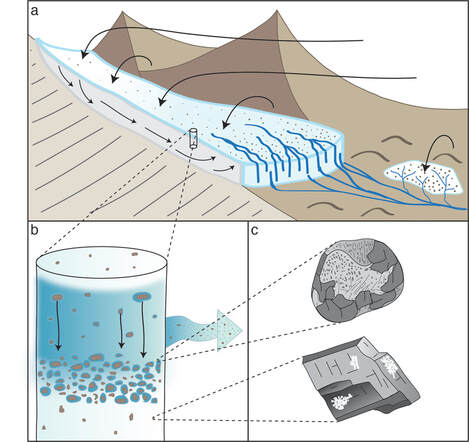
A new National Science Foundation project (NSF OPP #2148069) funded together with Anna Bergstrom (Boise State University), Melisa Diaz (University of Colorado Boulder) and Sue Welch (Ohio State University) will begin August 2022 and provide opportunities for geochemical lab work and data analysis for students in the Heindel Lab! I will be looking for students to join this project during the 2022-2023 academic year, for summer 2023, and beyond!
Glacial erosion produces large quantities of sediment that can change the chemistry of surrounding land and ocean ecosystems. While the nutrients underneath glaciers are known to be important for nearby biological communities, comparatively less is known about the chemistry and importance of glacier surfaces and snowpack, which can trap dust - small particles of rock that are deposited by wind and with snowfall. The dust is darker than ice and snow and therefore can warm during sunny periods and melt the surrounding frozen water, generating small amounts of liquid water. During cloudy and cold periods, solar radiation can no longer heat the particles and the liquid water around the dust freezes again. These thawing and freezing cycles can break down the dust and release nutrients, such as iron, which can potentially be used by organisms in the ice or can be transported to streams, lakes, and/or the ocean during periods of high melt. This research will combine computer modeling and laboratory experiments to understand 1) what happens (chemically and physically) to glacier and snowpack dust during freezing and thawing and 2) how to model freezing and thawing of water and dust in glacier ice. Two traveling exhibits exploring the connections between science and art will result from this project, allowing for diverse audiences to connect with the Antarctic continent and understand how small-scale science influences large-scale systems. The results of this study will determine the geochemistry of glacial meltwater due to freezing and thawing, and whether the meltwater contains critical nutrients for surrounding ecosystems.
Glacial erosion produces large quantities of sediment that can change the chemistry of surrounding land and ocean ecosystems. While the nutrients underneath glaciers are known to be important for nearby biological communities, comparatively less is known about the chemistry and importance of glacier surfaces and snowpack, which can trap dust - small particles of rock that are deposited by wind and with snowfall. The dust is darker than ice and snow and therefore can warm during sunny periods and melt the surrounding frozen water, generating small amounts of liquid water. During cloudy and cold periods, solar radiation can no longer heat the particles and the liquid water around the dust freezes again. These thawing and freezing cycles can break down the dust and release nutrients, such as iron, which can potentially be used by organisms in the ice or can be transported to streams, lakes, and/or the ocean during periods of high melt. This research will combine computer modeling and laboratory experiments to understand 1) what happens (chemically and physically) to glacier and snowpack dust during freezing and thawing and 2) how to model freezing and thawing of water and dust in glacier ice. Two traveling exhibits exploring the connections between science and art will result from this project, allowing for diverse audiences to connect with the Antarctic continent and understand how small-scale science influences large-scale systems. The results of this study will determine the geochemistry of glacial meltwater due to freezing and thawing, and whether the meltwater contains critical nutrients for surrounding ecosystems.
Atmospheric deposition along an urban to agricultural gradient in Ohio
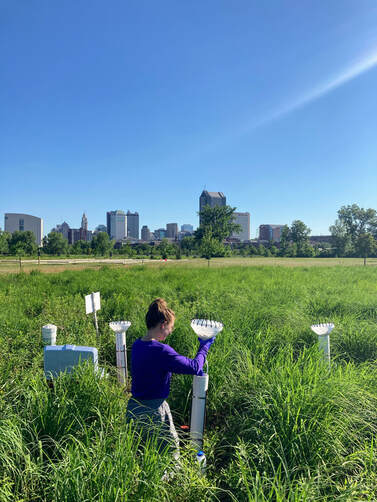
Atmospheric deposition rates of both nutrients and dust have increased substantially from pre-industrial levels. Changes in land use - both urban development and agriculture - are responsible for increasing emissions of both particulate matter and reactive nitrogen. Across the midwestern US, there are many sources of reactive nitrogen and particulate matter, but these sources can be hard to untangle and can vary significantly over time and space.
During the summer of 2021, we established an urban to agricultural transect from downtown Columbus to Gambier, OH. During the summers of 2021 and 2022, we collected weekly bulk deposition samples and are in the process of analyzing the particulate and liquid components for nutrients, major ions, lead isotopes, and trace element concentrations. The geochemistry of these samples will help us understand the source of pollutants that are deposited to central Ohio ecosystems.
During the academic year, we maintain our bulk deposition collection site at Kenyon College to study the seasonal variability in nutrient and particulate matter deposition. I am always looking for students interested in joining this effort! For credit or as part of the Kenyon Summer Science Program, students can participate in weekly sample collection and lab analyses contributing to our long-term record of atmospheric deposition in central Ohio.
During the summer of 2021, we established an urban to agricultural transect from downtown Columbus to Gambier, OH. During the summers of 2021 and 2022, we collected weekly bulk deposition samples and are in the process of analyzing the particulate and liquid components for nutrients, major ions, lead isotopes, and trace element concentrations. The geochemistry of these samples will help us understand the source of pollutants that are deposited to central Ohio ecosystems.
During the academic year, we maintain our bulk deposition collection site at Kenyon College to study the seasonal variability in nutrient and particulate matter deposition. I am always looking for students interested in joining this effort! For credit or as part of the Kenyon Summer Science Program, students can participate in weekly sample collection and lab analyses contributing to our long-term record of atmospheric deposition in central Ohio.
Land management impacts on soil health and carbon storage
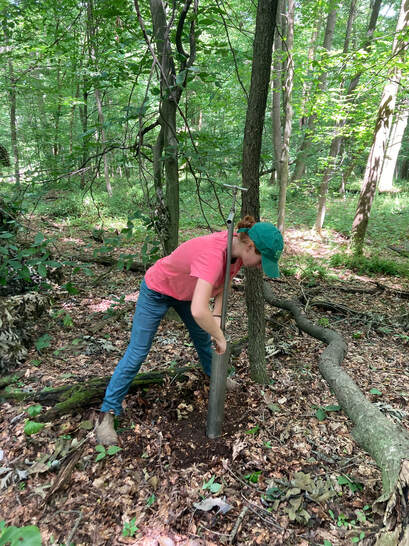
Soil health is critically important for food and economic security as well as for carbon storage and sequestration. Across the midwestern US, carbon-rich topsoil has been eroded and degraded with intensive agriculture. When land is taken out of conventional agriculture, recovery of organic matter and diverse microbial communities can take decades to centuries. At the Brown Family Environmental Center at Kenyon, much of the protected land was recently taken out of conventional agriculture, allowing us to study the impact of land management on the recovery of soil health and carbon storage. For this project, which has direct ties to Kenyon's carbon neutrality plan, we measure soil characteristics and soil carbon stocks across a range of restored prairies and successional forests.
Microbial and fungal diversity is an important aspect of soil health. Mycorrhizal fungi can form symbiotic relationships with plant roots, providing plants with greater access to limiting nutrients. The degree of mycorrhizal root colonization depends on soil characteristics and also on the land management strategies used, such as regular burning to maintain restored prairies.
This is an ongoing project with many opportunities for local fieldwork and lab analyses. For credit or as part of the Kenyon Summer Science Program, students can collect soil samples and conduct soil lab analyses, adding to our growing understanding of soil health and carbon storage at the Brown Family Environmental Center.
Microbial and fungal diversity is an important aspect of soil health. Mycorrhizal fungi can form symbiotic relationships with plant roots, providing plants with greater access to limiting nutrients. The degree of mycorrhizal root colonization depends on soil characteristics and also on the land management strategies used, such as regular burning to maintain restored prairies.
This is an ongoing project with many opportunities for local fieldwork and lab analyses. For credit or as part of the Kenyon Summer Science Program, students can collect soil samples and conduct soil lab analyses, adding to our growing understanding of soil health and carbon storage at the Brown Family Environmental Center.
Previous Research
Quantifying dust deposition to the Colorado Front Range
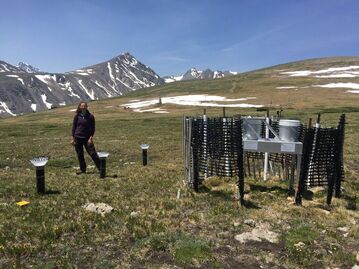
Due to land use change and drought, atmospheric dust deposition to the Rocky Mountains has been increasing over recent decades and is likely to continue increasing in the future. In the Colorado Front Range, most atmospheric deposition research has focused on alpine ecosystems, and little is known about deposition at lower elevations that are more proximal to urban and agricultural sources. To address this knowledge gap, we established atmospheric deposition collection sites along an elevation transect from Boulder up to the Continental Divide to quantify and characterize the inputs of dust.
Results of this research have been published in the Journal of Geophysical Research: Earth Surface. This project was funded by the Boulder Creek Critical Zone Observatory (NSF EAR-1331828), the Niwot Ridge Long-Term Ecological Research program (NSF DEB-1637686), and the City of Boulder Open Space and Mountain Parks Department.
Results of this research have been published in the Journal of Geophysical Research: Earth Surface. This project was funded by the Boulder Creek Critical Zone Observatory (NSF EAR-1331828), the Niwot Ridge Long-Term Ecological Research program (NSF DEB-1637686), and the City of Boulder Open Space and Mountain Parks Department.
Aerosolization of picocyanobacterial cells in Greenland and Antarctica
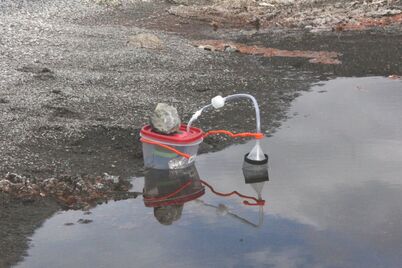
Bioaerosols are an important component of the total atmospheric aerosol load, with implications for human health, climate feedbacks, and the distribution and dispersal of microbial taxa. Little is known about the production of freshwater and terrestrial bioaerosols in polar regions. For this project, we used novel portable collection devices to test for the presence of picocyanobacterial aerosols above freshwater and soil substrates in the southwestern Greenland tundra and the McMurdo Dry Valleys of Antarctica.
Results of this research have been published in Environmental Microbiology Reports. This project was funded by the McMurdo Dry Valleys Long-Term Ecological Research program (NSF OPP-1115245) in Antarctica and the Joint Science Education Project (NSF OPP-1506155) in Greenland.
Results of this research have been published in Environmental Microbiology Reports. This project was funded by the McMurdo Dry Valleys Long-Term Ecological Research program (NSF OPP-1115245) in Antarctica and the Joint Science Education Project (NSF OPP-1506155) in Greenland.
Aeolian landscape change in the Kangerlussuaq region of West Greenland
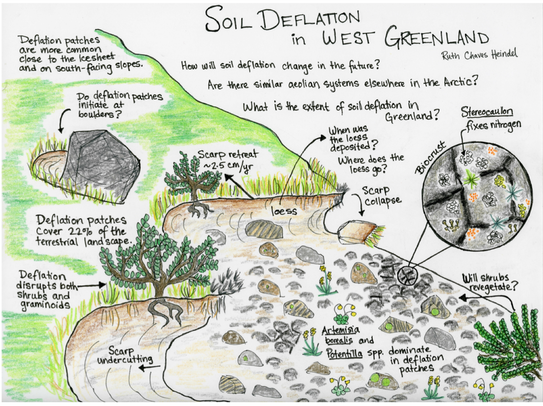
My dissertation research was an interdisciplinary investigation of aeolian soil erosion and its ecological consequences in West Greenland. Using remote sensing techniques, I mapped the spatial distribution of soil erosion in the Kangerlussuaq region. I estimated rates of soil erosion using lichenometry and Structure-from-Motion photogrammetry. Finally, I considered the ecological consequences of soil erosion and the establishment of a biological soil crust on the eroded soils.
Results of this project have been published in the Annals of the Association of American Geographers; The Holocene; Arctic, Antarctic, and Alpine Research; and Ecosystems. This project was supported by the IGERT in Polar Environmental Change at Dartmouth College (NSF DGE-0801490) as well as the Joint Science Education Project (NSF OPP-1506155).
Results of this project have been published in the Annals of the Association of American Geographers; The Holocene; Arctic, Antarctic, and Alpine Research; and Ecosystems. This project was supported by the IGERT in Polar Environmental Change at Dartmouth College (NSF DGE-0801490) as well as the Joint Science Education Project (NSF OPP-1506155).
Soil phosphorus weathering and availability in the McMurdo Dry Valleys
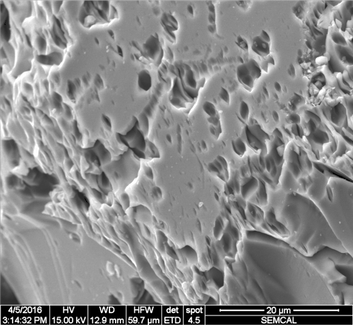
The weathering of the mineral apatite provides soils with available phosphorus, often a limiting nutrient. In the McMurdo Dry Valleys, patterns of available phosphorus in soils may be controlled by rates of mineral weathering. In this project, we looked both at landscape-scale variability in phosphorus availability as well as grain-scale indicators of apatite weathering, such as the etch pits in the scanning electron microscope image to the left (Sue Welch, Ohio State University).
Result of this project have been published in Antarctic Science and Geoderma. This project was funded by the McMurdo Dry Valleys Long-Term Ecological Research program (NSF OPP-1115245).
Result of this project have been published in Antarctic Science and Geoderma. This project was funded by the McMurdo Dry Valleys Long-Term Ecological Research program (NSF OPP-1115245).
Local dust storms in Adventdalen, Svalbard
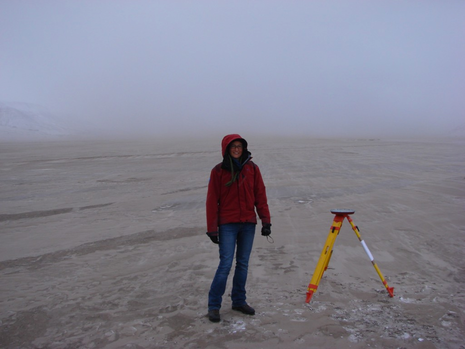
For my Senior Honors Thesis at Brown University, I studied local dust storms in Adventdalen, Svalbard. These storms carry sediment from the braided river floodplain of Adeventdalen out into the fjord. I found that these dust storms occur in the spring and fall, when temperatures are below freezing and relative humidity is low, but before a continuous snow cover develops.